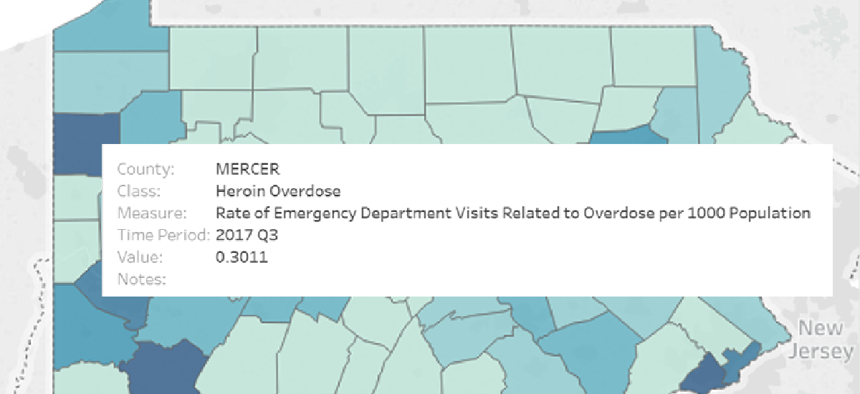Pennsylvania’s data-driven opioid strategy

A dashboard that tracks opioid prescriptions and emergency department visits helps the Opioid Operational Command Center identify overdose spikes and provide appropriate response.
When Pennsylvania Gov. Tom Wolf declared the opioid epidemic a statewide disaster in January, he tapped the Pennsylvania Emergency Management Agency to oversee a newly created Opioid Operational Command Center. The center tracks opioid prescription and overdose information collected by the Department of Health’s Prescription Drug Monitoring Program and emergency rooms across the state.
An interactive data visualization tool shows prescription dispensation trends for different classes of opioids over a year-long period ending in the third quarter of 2017. By tracking prescriptions and emergency department visits by county, the Opioid Operational Command Center can identify communities that are experiencing spikes in overdoses and provide appropriate response.
“This data is critical to not only determining where resources are needed, but to identify localized prescribing trends,” Acting Health Secretary and Physician General Rachel Levine said. “We will be able to use this tool to improve education and resources for prescribers to ensure that opioids are being prescribed judiciously to patients.”
The Department of Health developed the dashboard on the public version of Tableau’s visual analytics platform.
“Being able to easily see how this public health crisis impacts the public at a local level is a small but effective first step in addressing this crisis on a national level,” Sean Brophy, regional vice president of public sector at Tableau, said. “Our team at Tableau has always been available to answer questions and offer advice, such as suggestions based on similar projects in other states or regions, but the Department of Health team primarily developed this dashboard on their own.”
Thirteen state agencies are working together at the Command Center to combat the opioid epidemic. In the first three weeks of operation, the hotline that connects people to rehab centers has received more than 300 calls per week, according to the Pittsburgh Post-Gazette.
According to data from the Centers for Disease Control and Prevention, Pennsylvania has the third highest rate of drug overdoses. The Philadelphia division of the Drug Enforcement Agency reported 4,642 drug-related overdose deaths in 2016, an increase of 37 percent from 2015. Eighty-five percent of those deaths were related to opioids.
NEXT STORY: How local governments ensure an accurate census





